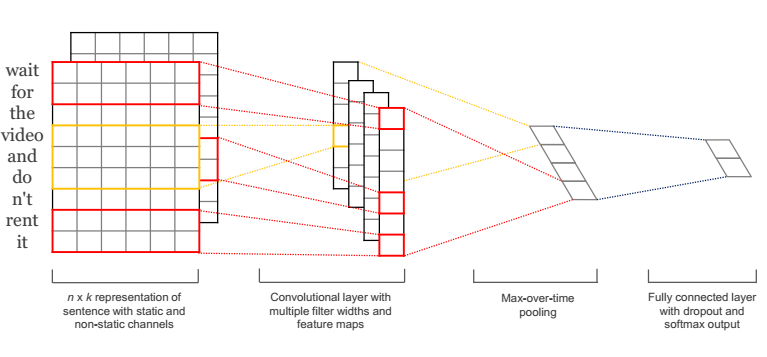论文原文:https://arxiv.org/abs/1408.5882
本文代码参考了http://www.wildml.com/2015/12/implementing-a-cnn-for-text-classification-in-tensorflow/
论文中采用CNN模型实现了电影评论的消极评论和积极评论的分类。模型的具体结构如下图所示。

图1 CNN文本分类模型
数据处理和模型训练的代码在此不再赘述
下文中的代码为模型构建的代码
import tensorflow as tf import numpy as np class TextCNN(object): """ A CNN for text classification. Uses an embedding layer, followed by a convolutional, max-pooling and softmax layer. """ def __init__( self, sequence_length, num_classes, vocab_size, embedding_size, filter_sizes, num_filters, l2_reg_lambda=0.0): # Placeholders for input, output and dropout self.input_x = tf.placeholder(tf.int32, [None, sequence_length], name="input_x") self.input_y = tf.placeholder(tf.float32, [None, num_classes], name="input_y") self.dropout_keep_prob = tf.placeholder(tf.float32, name="dropout_keep_prob") # Keeping track of l2 regularization loss (optional) l2_loss = tf.constant(0.0) # Embedding layer with tf.device('/cpu:0'), tf.name_scope("embedding"): self.W = tf.Variable( tf.random_uniform([vocab_size, embedding_size], -1.0, 1.0), name="W") self.embedded_chars = tf.nn.embedding_lookup(self.W, self.input_x) self.embedded_chars_expanded = tf.expand_dims(self.embedded_chars, -1) # Create a convolution + maxpool layer for each filter size pooled_outputs = [] for i, filter_size in enumerate(filter_sizes): with tf.name_scope("conv-maxpool-%s" % filter_size): # Convolution Layer filter_shape = [filter_size, embedding_size, 1, num_filters] W = tf.Variable(tf.truncated_normal(filter_shape, stddev=0.1), name="W") b = tf.Variable(tf.constant(0.1, shape=[num_filters]), name="b") conv = tf.nn.conv2d( self.embedded_chars_expanded, W, strides=[1, 1, 1, 1], padding="VALID", name="conv") # Apply nonlinearity h = tf.nn.relu(tf.nn.bias_add(conv, b), name="relu") # Maxpooling over the outputs pooled = tf.nn.max_pool( h, ksize=[1, sequence_length - filter_size + 1, 1, 1], strides=[1, 1, 1, 1], padding='VALID', name="pool") pooled_outputs.append(pooled) # Combine all the pooled features num_filters_total = num_filters * len(filter_sizes) self.h_pool = tf.concat(pooled_outputs, 3) self.h_pool_flat = tf.reshape(self.h_pool, [-1, num_filters_total]) # Add dropout with tf.name_scope("dropout"): self.h_drop = tf.nn.dropout(self.h_pool_flat, self.dropout_keep_prob) # Final (unnormalized) scores and predictions with tf.name_scope("output"): W = tf.get_variable( "W", shape=[num_filters_total, num_classes], initializer=tf.contrib.layers.xavier_initializer()) b = tf.Variable(tf.constant(0.1, shape=[num_classes]), name="b") l2_loss += tf.nn.l2_loss(W) l2_loss += tf.nn.l2_loss(b) self.scores = tf.nn.xw_plus_b(self.h_drop, W, b, name="scores") self.predictions = tf.argmax(self.scores, 1, name="predictions") # Calculate mean cross-entropy loss with tf.name_scope("loss"): losses = tf.nn.softmax_cross_entropy_with_logits(logits=self.scores, labels=self.input_y) self.loss = tf.reduce_mean(losses) + l2_reg_lambda * l2_loss # Accuracy with tf.name_scope("accuracy"): correct_predictions = tf.equal(self.predictions, tf.argmax(self.input_y, 1)) self.accuracy = tf.reduce_mean(tf.cast(correct_predictions, "float"), name="accuracy")